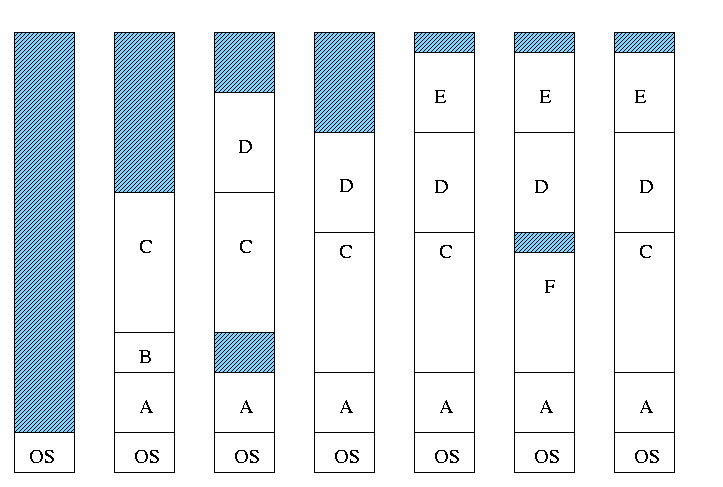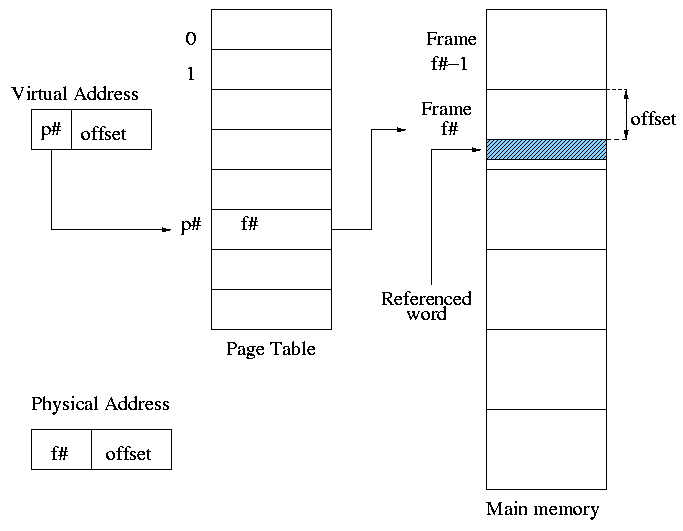================ Start Lecture #10
================
Note: Typo on lab 2.
The last input set has a process with a zero
value for IO, which is an error. Specifically, you should replace
5 (0 3 200 3) (0 9 500 3) (0 20 500 3) (100 1 100 0) (100 100 500 3)
with
5 (0 3 200 3) (0 9 500 3) (0 20 500 3) (100 1 100 3) (100 100 500 3)
End of Note.
3.2: Swapping
Moving entire processes between disk and memory is called
swapping.
3.2.1: Multiprogramming with variable partitions
- Both the number and size of the partitions change with time.
- IBM OS/MVT (multiprogramming with a varying number of tasks).
- Also early PDP-10 OS.
- Job still has only one segment (as with MFT) but now can be of any
size up to the size of the machine and can change with time.
- A single ready list.
- Job can move (might be swapped back in a different place).
- This is dynamic address translation (during run time).
- Must perform an addition on every memory reference (i.e. on every
address translation) to add the start address of the partition.
- Called a DAT (dynamic address translation) box by IBM.
- Eliminates internal fragmentation.
- Find a region the exact right size (leave a hole for the
remainder).
- Not quite true, can't get a piece with 10A755 bytes. Would
get say 10A760. But internal fragmentation is much
reduced compared to MFT. Indeed, we say that internal
fragmentation has been eliminated.
- Introduces external fragmentation, i.e., holes
outside any region.
- What do you do if no hole is big enough for the request?
- Can compactify
- Transition from bar 3 to bar 4 in diagram below.
- This is expensive.
- Not suitable for real time (MIT ping pong).
- Can swap out one process to bring in another
- Bars 5-6 and 6-7 in diagram

Homework: 4
- There are more processes than holes. Why?
- Because next to a process there might be a process or a hole
but next to a hole there must be a process
- So can have ``runs'' of processes but not of holes
- If after a process equally likely to have a process or a hole,
you get about twice as many processes as holes.
- Base and limit registers are used.
- Storage keys not good since compactifying would require
changing many keys.
- Storage keys might need a fine granularity to permit the
boundaries move by small amounts. Hence many keys would need to be
changed
MVT Introduces the ``Placement Question'', which hole (partition)
to choose
- Best fit, worst fit, first fit, circular first fit, quick fit, Buddy
- Best fit doesn't waste big holes, but does leave slivers and
is expensive to run.
- Worst fit avoids slivers, but eliminates all big holes so a
big job will require compaction. Even more expensive than best
fit (best fit stops if it finds a perfect fit).
- Quick fit keeps lists of some common sizes (but has other
problems, see Tanenbaum).
- Buddy system
- Round request to next highest power of two (causes
internal fragmentation).
- Look in list of blocks this size (as with quick fit).
- If list empty, go higher and split into buddies.
- When returning coalesce with buddy.
- Do splitting and coalescing recursively, i.e. keep
coalescing until can't and keep splitting until successful.
- See Tanenbaum for more details (or an algorithms book).
- A current favorite is circular first fit (also know as next fit)
- Use the first hole that is big enough (first fit) but start
looking where you left off last time.
- Doesn't waste time constantly trying to use small holes that
have failed before, but does tend to use many of the big holes,
which can be a problem.
- Buddy comes with its own implementation. How about the others?
- Bit map
- Only question is how much memory does one bit represent.
- Big: Serious internal fragmentation
- Small: Many bits to store and process
- Linked list
- Each item on list says whether Hole or Process, length,
starting location
- The items on the list are not taken from the memory to be
used by processes
- Keep in order of starting address
- Double linked
- Boundary tag
- Knuth
- Use the same memory for list items as for processes
- Don't need an entry in linked list for blocks in use, just
the avail blocks are linked
- For the blocks currently in use, just need a hole/process bit at
each end and the length. Keep this in the block itself.
- See knuth, the art of computer programming vol 1
Homework: 2, 5.
MVT Also introduces the ``Replacement Question'', which victim to
swap out
We will study this question more when we discuss
demand paging.
Considerations in choosing a victim
- Cannot replace a job that is pinned,
i.e. whose memory is tied down. For example, if Direct Memory
Access (DMA) I/O is scheduled for this process, the job is pinned
until the DMA is complete.
- Victim selection is a medium term scheduling decision
- Job that has been in a wait state for a long time is a good candidate.
- Often choose as a victim a job that has been in memory for a long
time.
- Another point is how long should it stay swapped out.
- For demand paging, where swaping out a page is not as drastic as
swapping out a job, choosing the victim is an important memory
management decision and we shall study several policies,
NOTEs:
- So far the schemes presented have had two properties:
- Each job is stored contiguously in memory. That is, the job is
contiguous in physical addresses.
- Each job cannot use more memory than exists in the system. That
is, the virtual addresses space cannot exceed the physical address
space.
- Tanenbaum now attacks the second item. I wish to do both and start
with the first.br>
- Tanenbaum (and most of the world) uses the term ``paging'' to mean
what I call demand paging. This is unfortunate as it mixes together
two concepts.
- Paging (dicing the address space) to solve the placement
problem and essentially eliminate external fragmentation.
- Demand fetching, to permit the total memory requirements of
all loaded jobs to exceed the size of physical memory.
- Tanenbaum (and most of the world) uses the term virtual memory as
a synonym for demand paging. Again I consider this unfortunate.
- Demand paging is a fine term and is quite descriptive
- Virtual memory ``should'' be used in contrast with physical
memory to describe any virtual to physical address translation.
** (non-demand) Paging
Simplest scheme to remove the requirement of contiguous physical
memory.
- Chop the program into fixed size pieces called
pages (invisible to the programmer).
- Chop the real memory into fixed size pieces called page
frames or simply frames.
- Size of a page (the page size) = size of a frame (the frame size).
- Sprinkle the pages into the frames.
- Keep a table (called the page table) having an
entry for each page. The page table entry or PTE for
page p contains the number of the frame f that contains page p.



